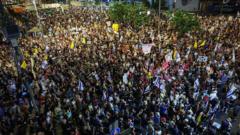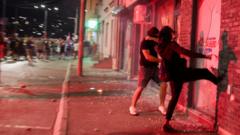Demonstrators in Mexico City clashed over rising living costs and the impact of tourism, resulting in damage to businesses and criticism from officials. The protests reflect local frustrations amid increasing gentrification fueled by an influx of foreign residents.
Protests Erupt in Mexico City as Residents Clash with Rising Tourism and Costs

Protests Erupt in Mexico City as Residents Clash with Rising Tourism and Costs
A recent protest in Mexico City escalated into violence as residents voice their anger over soaring rents and the influx of tourists, highlighting the growing tensions between locals and expatriates.
Protests in Mexico City against escalating living costs and an uptick in tourism culminated in violence late Friday, leading to property damage across several businesses and igniting concerns among city officials. The unrest illustrates the mounting frustration of locals coping with soaring rents and the transformation of once-familiar neighborhoods into upscale developments, as the city increasingly attracts Western immigrants seeking a vibrant urban experience.
Initially, the protest began peacefully, with hundreds marching to express their discontent. Participants carried signs with messages such as “Your new home is an invasion,” “We shouldn’t feel like foreigners in our own land,” and “Expat = gentrifier.” However, tension escalated when a faction of the protesters turned aggressive, vandalizing storefronts—including a Starbucks and a bank—while spray-painting walls and looting retailers in affluent districts such as Condesa and Roma.
Officials reported that around fifteen businesses sustained damage, with city government secretary, César Cravioto, expressing the need to curb the escalation of violence associated with what he described as “xenophobic” protests. He emphasized that Mexico City has a rich history of migration and that such demonstrations do not align with the values of the city's government.
Governor Carla Brugada acknowledged the detrimental effects of gentrification on longtime residents, confirming efforts to improve affordable housing. Nonetheless, she condemned the violent actions of the protests, stressing that opposition to gentrification should not spiral into discrimination against migrants.
Since the COVID-19 pandemic, upscale neighborhoods like Roma and Condesa have experienced a significant influx of foreigners drawn by the lower cost of living and the attractiveness of remote work opportunities. While this migration has benefited local businesses and landlords, it has concurrently rendered vast areas of the city unaffordable for many residents, who earn an average monthly wage of only $370.
Some demonstrators likened the ongoing influx of American and European newcomers to modern colonialism. Frente Anti Gentrificación Mx, a grassroots organization behind the march, dichotomously branded their movement as a counteraction to “American imperialism” on social media, characterizing gentrification as a “silent expulsion” of local populations.
The unrest in Mexico City reflects a larger global trend of protests against mass tourism and soaring living costs, resonating with similar movements recently observed in cities across Italy, Portugal, and Spain.

















